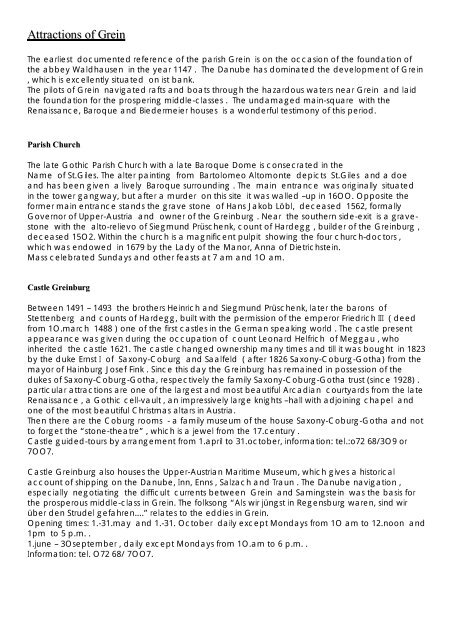You also want an ePaper? Increase the reach of your titles
YUMPU automatically turns print PDFs into web optimized ePapers that Google loves.
Attractions of Gre<strong>in</strong><br />
The earliest documented reference of the parish Gre<strong>in</strong> is on the occasion of the foundation of<br />
the abbey Waldhausen <strong>in</strong> the year 1147 . The Danube has dom<strong>in</strong>ated the development of Gre<strong>in</strong><br />
, which is excellently situated on ist bank.<br />
The pilots of Gre<strong>in</strong> navigated rafts and boats through the hazardous waters near Gre<strong>in</strong> and laid<br />
the foundation for the prosper<strong>in</strong>g middle-classes . The undamaged ma<strong>in</strong>-square with the<br />
Renaissance, Baroque and Biedermeier houses is a wonderful testimony of this period.<br />
Parish Church<br />
The late Gothic Parish Church with a late Baroque Dome is consecrated <strong>in</strong> the<br />
Name of St.Giles. The alter pa<strong>in</strong>t<strong>in</strong>g from Bartolomeo Altomonte depicts St.Giles and a doe<br />
and has been given a lively Baroque surround<strong>in</strong>g . The ma<strong>in</strong> entrance was orig<strong>in</strong>ally situated<br />
<strong>in</strong> the tower gangway, but after a murder on this site it was walled –up <strong>in</strong> 16OO. Opposite the<br />
former ma<strong>in</strong> entrance stands the grave stone of Hans Jakob Löbl, deceased 1562, formally<br />
Governor of Upper-Austria and owner of the Gre<strong>in</strong>burg . Near the southern side-exit is a gravestone<br />
with the alto-relievo of Siegmund Prüschenk, count of Hardegg , builder of the Gre<strong>in</strong>burg ,<br />
deceased 15O2. With<strong>in</strong> the church is a magnificent pulpit show<strong>in</strong>g the four church-doctors ,<br />
which was endowed <strong>in</strong> 1679 by the Lady of the Manor, Anna of Dietrichste<strong>in</strong>.<br />
Mass celebrated Sundays and other feasts at 7 am and 1O am.<br />
Castle Gre<strong>in</strong>burg<br />
Between 1491 – 1493 the brothers He<strong>in</strong>rich and Siegmund Prüschenk, later the barons of<br />
Stettenberg and counts of Hardegg, built with the permission of the emperor Friedrich III ( deed<br />
from 1O.march 1488 ) one of the first castles <strong>in</strong> the German speak<strong>in</strong>g world . The castle present<br />
appearance was given dur<strong>in</strong>g the occupation of count Leonard Helfrich of Meggau , who<br />
<strong>in</strong>herited the castle 1621. The castle changed ownership many times and till it was bought <strong>in</strong> 1823<br />
by the duke Ernst I of Saxony-Coburg and Saalfeld ( after 1826 Saxony-Coburg-Gotha) from the<br />
mayor of Ha<strong>in</strong>burg Josef F<strong>in</strong>k . S<strong>in</strong>ce this day the Gre<strong>in</strong>burg has rema<strong>in</strong>ed <strong>in</strong> possession of the<br />
dukes of Saxony-Coburg-Gotha, respectively the family Saxony-Coburg-Gotha trust (s<strong>in</strong>ce 1928) .<br />
particular attractions are one of the largest and most beautiful Arcadian courtyards from the late<br />
Renaissance , a Gothic cell-vault , an impressively large knights –hall with adjo<strong>in</strong><strong>in</strong>g chapel and<br />
one of the most beautiful Christmas altars <strong>in</strong> Austria.<br />
Then there are the Coburg rooms - a family museum of the house Saxony-Coburg-Gotha and not<br />
to forget the “stone-theatre” , which is a jewel from the 17.century .<br />
Castle guided-tours by arrangement from 1.april to 31.october, <strong>in</strong>formation: tel.:o72 68/3O9 or<br />
7OO7.<br />
Castle Gre<strong>in</strong>burg also houses the Upper-Austrian Maritime Museum, which gives a historical<br />
account of shipp<strong>in</strong>g on the Danube, Inn, Enns , Salzach and Traun . The Danube navigation ,<br />
especially negotiat<strong>in</strong>g the difficult currents between Gre<strong>in</strong> and Sam<strong>in</strong>gste<strong>in</strong> was the basis for<br />
the prosperous middle-class <strong>in</strong> Gre<strong>in</strong>. The folksong “Als wir jüngst <strong>in</strong> Regensburg waren, s<strong>in</strong>d wir<br />
über den Strudel gefahren....” relates to the eddies <strong>in</strong> Gre<strong>in</strong>.<br />
Open<strong>in</strong>g times: 1.-31.may and 1.-31. October daily except Mondays from 1O am to 12.noon and<br />
1pm to 5 p.m. .<br />
1.june – 3Oseptember , daily except Mondays from 1O.am to 6 p.m. .<br />
Information: tel. O72 68/ 7OO7.
The old <strong>Town</strong>-Hall<br />
It was built <strong>in</strong> 1563 by the Italian master-builder Max Canaval from lake Como. The Canaval<br />
family was also <strong>in</strong>volved <strong>in</strong> the construction of the L<strong>in</strong>z<br />
Council build<strong>in</strong>gs ( Upper –Austrian State Government) . Also <strong>in</strong>volved <strong>in</strong> the project was the<br />
“Welsche Builder “ Jakob Kurz . The build<strong>in</strong>g is unchanged to the present day, later a granary was<br />
built onto the <strong>Town</strong> Hall, which was converted <strong>in</strong>to a theatre <strong>in</strong> 1791.<br />
<strong>Old</strong> <strong>Town</strong> –Theatre<br />
This impressive theatre , built <strong>in</strong> Rococo-style, is the oldest secular theatre <strong>in</strong> Austria , preserved <strong>in</strong><br />
orig<strong>in</strong>al form . Dur<strong>in</strong>g the month of July and August a professional troupe play <strong>in</strong> the theatre and<br />
<strong>in</strong> autumn a local group of actors and actresses. Tickets available from the bookshop H<strong>in</strong>terecker<br />
(tel.O72 68/ 373). The first three rows of seats were built <strong>in</strong> a style that is the only still exist<strong>in</strong>g . The<br />
seats can be folded and locked , which give them the name “Sperrsitze”. The theatre was<br />
furnished and decorated by hand-workers from Gre<strong>in</strong>. Two further curiosities should not go<br />
without mention, first of all the “Council Dungeon” and secondly an unusual archaic toilet.<br />
More <strong>in</strong>formation by the guided tours , which take place regularly between 1.April and<br />
31.October at 9 am , 11 am, 1.3O p.m. and 4 p.m. Special tours by appo<strong>in</strong>tment.<br />
Book<strong>in</strong>gs: Tourismusverband Gre<strong>in</strong> , tel./fax O7268/7O 55<br />
St.Anthony House (Ma<strong>in</strong> entrance Klostergasse 6, second entrance Dampfschiffgasse Nr.3) Built<br />
orig<strong>in</strong>ally <strong>in</strong> 1622 for the course of the counter reform , as a Franciscan monastery. On the smooth<br />
wall surface are w<strong>in</strong>dows with flat – profile stone surround<strong>in</strong>gs and on the ground floor to the<br />
left is a oval ox-eye shaped w<strong>in</strong>dow with a primitive wooden frame . A stone door surround<strong>in</strong>g<br />
with fan –light and the orig<strong>in</strong>al wooden doors from around 18OO.<br />
From the upper-storey one can reach part of the former cloister gang-way which has a long<br />
barrel-vault with cruciform-gro<strong>in</strong>s. From the side is a view onto the monastery-courtyard with a<br />
founta<strong>in</strong> with a octagonal granite surround<strong>in</strong>g . The cloister gangway borders the courtyard on<br />
three sides . The monastery was dissolved dur<strong>in</strong>g the reign of emperor Joseph II and later used as<br />
a adm<strong>in</strong>istration build<strong>in</strong>g and jail. The build<strong>in</strong>g is now used as orig<strong>in</strong>ally <strong>in</strong>tended for<br />
contemplation and spiritual devotions .<br />
The <strong>Town</strong> Founta<strong>in</strong><br />
Situated on the town-square the founta<strong>in</strong> is otherwise known as the Meggau-Founta<strong>in</strong> , which was<br />
built <strong>in</strong> the year 1872 . The founta<strong>in</strong> was built to honour the count of Meggau who cared for the<br />
social welfare of the <strong>in</strong>habitants of Gre<strong>in</strong>. The first founta<strong>in</strong> was built as early as 16OO, this founta<strong>in</strong><br />
now stands <strong>in</strong> front of the church <strong>in</strong> Bad Kreuzen .<br />
The Stone Founta<strong>in</strong><br />
It is situated on the Danube side of the new town-hall, <strong>in</strong> documents referred to as “Gigerlitz<br />
Founta<strong>in</strong>” , was built by the Italian master stone-mason Spozzi around 1636. The co<strong>in</strong>s thrown <strong>in</strong>to<br />
the founta<strong>in</strong> should enable the donators a happy return to Gre<strong>in</strong>. It is also said of the founta<strong>in</strong>,<br />
that people who have drank from it often return to Gre<strong>in</strong>.<br />
Halter Cross<br />
Situated on the Danube, it was erected before the “ Schwalleck”, formally a dangerous<br />
hazardous part of the Danube. It rem<strong>in</strong>ds us of the wondrous rescue of the shepherd boy (Halter)<br />
from the Danube currents.<br />
Blue Cross <strong>in</strong> Kreuzner road
(Situated after the railway viaduct), this monstrance like wayside shr<strong>in</strong>e was erected <strong>in</strong> 165O by<br />
Sigmund Ludwig, count of Dietrichste<strong>in</strong>, prais<strong>in</strong>g the end of the thirty-years war.<br />
Kalvarienberg-Chapel<br />
A functional build<strong>in</strong>g , which displays life-size figures of the crucified, the two thieves, as well as the<br />
three assist<strong>in</strong>g figures: virg<strong>in</strong> Mary, Sa<strong>in</strong>t Magdalene and Sa<strong>in</strong>t John. The mounted sculptures are a<br />
f<strong>in</strong>e example of late Baroque expression from the late 18. Century<br />
<strong>Old</strong> <strong>Town</strong> <strong>Houses</strong> <strong>in</strong> Gre<strong>in</strong><br />
<strong>Town</strong>-square Nr.3. Impos<strong>in</strong>g gable-house – constructional core from 16.century. The fascia is made<br />
of orig<strong>in</strong>al graffito bands, with ornamental chimera reveal<strong>in</strong>g rhombi and circular patterns . On<br />
the upper storey is an <strong>in</strong>terest<strong>in</strong>g net-vault display<strong>in</strong>g narrow graphic gro<strong>in</strong>s and lightly alveolate<br />
spandrels.<br />
<strong>Town</strong>-square Nr.4 . Core 17.century, with<strong>in</strong> are barrel-vaulted rooms with caps which have piped-<br />
gro<strong>in</strong>s.The facade is designed <strong>in</strong> neo-gothic<br />
style. The oriel- tower is decorated with a unusual amalgamation of ornamental Renaissance<br />
fitt<strong>in</strong>gs and “ Jugendstil” from around 19OO.<br />
<strong>Town</strong>-square Nr.5. A former <strong>in</strong>n from the mid 16.century, a wide tw<strong>in</strong> build<strong>in</strong>g with rounded orieltowers<br />
and a –cover<strong>in</strong>g several axis – cont<strong>in</strong>ues recess on a protrud<strong>in</strong>g corbel stone. The<br />
w<strong>in</strong>dows have profiled stone surround<strong>in</strong>gs . On the upper level there are small w<strong>in</strong>dows mounted<br />
<strong>in</strong> stone frames with typical protrud<strong>in</strong>g fluted outer-sills. The <strong>in</strong>terior has a barrel-vault with po<strong>in</strong>ted<br />
caps from the mid 17.century .<br />
<strong>Town</strong> –square Nr.6. Former boat masters house – an immense cube formed build<strong>in</strong>g- the core<br />
be<strong>in</strong>g 16.century – with a round corner tower on stepped corbel stones. On the smooth , largely<br />
unbroken wall surface is a rustic w<strong>in</strong>dow frame which was built <strong>in</strong>to the plaster <strong>in</strong> the mid<br />
18.century. On the upper level , surround<strong>in</strong>g the courtyard on two sides is an elegant arcade,<br />
mounted on stone piers. The somewhat characteristic balustrade is divided <strong>in</strong>to quadratic<br />
segments and stands on several heavy, stepped corbel stones and stone piers ( entry through<br />
gate) . In the coffee –shop is a ceil<strong>in</strong>g with wooden beams and chip-carved ornaments . The<br />
<strong>in</strong>terior is <strong>in</strong> typical Biedermeier-style from around 19OO.<br />
<strong>Town</strong>-square Nr.8. Large construction built on a u-formed ground-plan , at it´s core, 16.century,<br />
ma<strong>in</strong>ly smooth unbroken wall-surface with modest ornament . Smooth horizontal stripes between<br />
the storeys, all w<strong>in</strong>dows have flat-bar frames sunk <strong>in</strong> plaster.<br />
Feldgasse—corner Hauptstraße , characteristic decoration <strong>in</strong> stucco pl<strong>in</strong>ths. On ground-floor are<br />
skylights from around 183O<br />
<strong>Town</strong>-square Nr.9. Slop<strong>in</strong>g gable-house with attractive late Baroque striped decoration .<br />
Donaugasse Nr.1. 16.century, house gate mounted <strong>in</strong> Roman-arch style stone surround . On ground<br />
-floor are two wrought –iron lattices from around 182O-183O. With<strong>in</strong> a very wide cruciform-ribbedvault.<br />
Donaugasse Nr.3. Facade has characteristic terracotta decoration – mid 19.century<br />
Donaulände Nr.4 ( Formally Donaugasse 15) Rema<strong>in</strong>s of terracotta ornamentation from around<br />
185O. In flat recesses are four putti play<strong>in</strong>g musical <strong>in</strong>struments.<br />
Hauptstraße Nr.2. <strong>Old</strong> house built on to the church at the rear , core 16.century. Built along side<br />
the Donaugasse, with notably deep , almost slot-like segmental arched w<strong>in</strong>dows. Entrance door
has a smooth late Baroque stone surround with a horizontal oblong skylight from the late<br />
18.century. The <strong>in</strong>terior has a net-vault with noticeably graphic gro<strong>in</strong>s. Shop from late 18.century—<br />
above is a w<strong>in</strong>dow with sills from the mid 16.century—on the roof is a dormer w<strong>in</strong>dow from the<br />
Baroque period.<br />
Hauptstraße Nr.3 ( Goldene Krone) Large road-side gable-house with modern facade decoration<br />
– core is 16.century from which several attractive vaulted rooms rema<strong>in</strong> . On the ground-floor (<br />
guest room) is a ceil<strong>in</strong>g with wooden beams treated <strong>in</strong> ox-blood.<br />
Hauptstraße Nr.5. Road-side gable-house – core 16.century with Biedermeier facade.<br />
Hauptstraße Nr. 8. Neo-Baroque facade decoration made up of <strong>in</strong>dustrial plaster pl<strong>in</strong>ths .<br />
Hauptstraße Nr.1O. Formally guest house Goldener Hirsch , core 16.century . The facade<br />
ornamentation is with <strong>in</strong>dustrial decorative pl<strong>in</strong>ths from the mid 19.century , the layout is<br />
rem<strong>in</strong>iscent of Biedermeier and is from the year 183O. With<strong>in</strong> is a wooden beamed ceil<strong>in</strong>g<br />
decorated with chip-carv<strong>in</strong>gs from around 17OO.<br />
Hauptstraße Nr.11. The core is 16.century. The <strong>in</strong>terior has a cruciform-ribbed-vault with graphic<br />
gro<strong>in</strong>s. House door with fitt<strong>in</strong>gs from around 18OO.<br />
Hauptstraße Nr.17. Orig<strong>in</strong>al terracotta ornamentation from mid 19.century.<br />
Hauptstraße Nr.2O. Road side gable-house with characteristic facade decoration from the mid<br />
19.century. Ground-floor rem<strong>in</strong>iscent of the period from around 182O.<br />
Hauptstraße Nr. 26. Constructional core is late Gothic with flat oriels stand<strong>in</strong>g on corbel stones. On<br />
the side fac<strong>in</strong>g the road is a slop<strong>in</strong>g gable .<br />
Hauptstraße Nr. 34. Late Baroque build<strong>in</strong>g with a flat triangular pediment above the centre.<br />
Hauptstraße Nr. 39. Road side gable-house with modest plaster structur<strong>in</strong>g <strong>in</strong> late Baroque style .<br />
Hauptstraße Nr.43. High road side gable-house with notable facade ornamentation from the mid<br />
19.century. Wrought-ironed name-plate <strong>in</strong> key-form from around 18OO (Mäander, Rosette) .<br />
Hauptstraße Nr. 45. Constructional core 16.century. Formally iron-mongers house with Biedermeier<br />
facade decorated with rocaille . In the courtyard are two w<strong>in</strong>dow lattices made of wrought-iron<br />
from around 182O.<br />
Sun dial on the Danube promenade . S<strong>in</strong>ce the summer of 1993 the bank of the Danube, <strong>in</strong> the region<br />
of Esperanto-square is enriched by the presence of a remarkable measurer of time , which was<br />
designed and built by the physics and astronomy student Werner Riegler from Gre<strong>in</strong>. This type of<br />
sun dial carries the name equatorial sun dial, by which the shadow created by a cord runn<strong>in</strong>g<br />
parallel to the axis falls onto a scale. From a semi-cyl<strong>in</strong>drical dial it is then possible to read the<br />
time, with a tolerance of around two m<strong>in</strong>utes. The dials frame work is made of chrome- nickelsteel,<br />
the dial and scales are made of brass. Additional to the time <strong>in</strong>dication there is a granite<br />
ball mounted at the front. This globe, with the cont<strong>in</strong>ents engraved <strong>in</strong>to it, has the sun sh<strong>in</strong><strong>in</strong>g<br />
down onto it, <strong>in</strong> the same way as the earth itself. It is therefore possible , observ<strong>in</strong>g the shadow<br />
boundaries to identify the countries <strong>in</strong> which the sun is actually sh<strong>in</strong><strong>in</strong>g. The fasc<strong>in</strong>at<strong>in</strong>g aspect of<br />
such a sun-dial , is that the way it functions is easy to understand – consequently learn<strong>in</strong>g the<br />
relationship between the earth´s and sun´s movements without any difficulty.<br />
Information and book<strong>in</strong>gs for city- and theatre guided-tours:<br />
Tourismusverband Gre<strong>in</strong>, Tel/fax: 07268/70 55<br />
e-m@il: <strong>in</strong>fo.gre<strong>in</strong>@upperaustria.or.at





